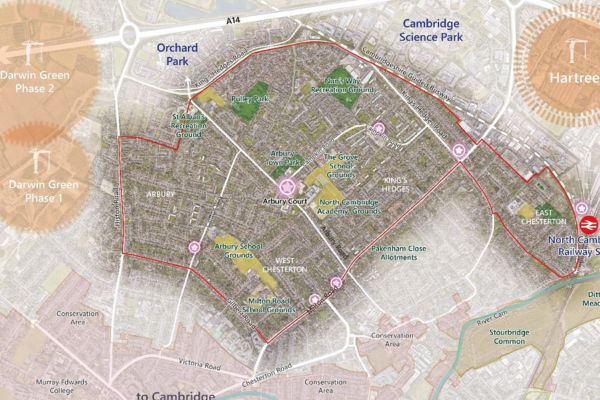We’ll give you a free tree to plant in your garden to mark your baby’s birth. You can also apply if you want to celebrate an adoption or commemorate a lost child.
To qualify, you must live in Cambridge and have a child or grandchild aged four or younger. You must have space in your garden or elsewhere to plant the tree – we cannot plant it in our parks or open spaces.
If you do not have a garden or other space for a new tree, you can still apply for one. You’ll need to arrange to plant it elsewhere in Cambridge, so it contributes to the city’s urban forest. This might be at your place of work, your child’s school or nursery, or in a family member’s garden.
We encourage the planting of trees in gardens and promote the many benefits they bring to the city. Our short video about trees in Cambridge introduces our Trees for Babies scheme and the work we do to plant and protect trees.
Apply for your tree
The scheme is open for applications from early November until the end of the following August. So if you apply in November, December or January, it will be more than a year before you can collect your tree.
We order all the trees in a single batch, usually in November – we’ll let you know when have done this.
Choose your tree
The choice of available trees can change from year to year. Some will grow larger than others, but they should all grow well in Cambridge gardens.
You don’t need to worry too much about soil type or the amount of available light. We’ll let you know if the tree you choose needs any special treatment.
Think about how much room you have and the size the tree will grow to. Try to find a space where it can grow to its fullest without needing regular pruning or becoming a nuisance or hazard.
After that you just need to consider what you like in a tree, such as blossom, or edible fruit.
You can see a list of trees that were available in 2019 at the bottom of the page.
Collect your tree
We aim to have the trees ready for you to pick up in the winter, which is the best time to plant. We try to run pick-up events during the February half-term holiday, although they might take place earlier or later.
We’ll send you all the details as soon as we can – most likely in January.
As well as your tree, we’ll give you a stake and tie if you need it, some mulch, and a guide to planting and caring for your tree [link].
Plant your tree
Depending on which type of tree you chose, it will probably measure between 0.5 and 2.5 metres in height when you collect it. It will be either potted in a plastic pot, or bare root in a plastic bag without any soil or compost.
You can plant a potted tree whenever it’s convenient. Bare-root trees need a bit more care if you’re unable to plant them immediately. We recommend planting it temporarily in a shallow trench or large pot, with the roots covered in damp compost.
Some smaller fruit trees can grow for up to 10 years in large pots. Most other trees tend to be hard to maintain when planted in a pot, because of the lack of water and nutrients. If this is your only option, use as large a pot as possible with a soil-based compost, and water it regularly.
Available trees
In 2019, claimants could choose from the following trees:
- Amelanchier (Amelanchier laevis)
- A pretty, small tree with a broadly spreading crown ideal for smaller gardens. A tree for all seasons, the leaves open a coppery pink in the early spring, soon followed by sprays of pretty star-like flowers. Round, juicy, purple-black fruit ripens by July where birds make short work of them before the leaves go to a bright red in the autumn. Amelanchier will grow in sun and most soils.
- Dessert apple (Malus domestica variety)
- Table apples or dessert apples are a group of apple cultivars grown for eating raw as opposed to cooking or cider making. Table apples are usually sweet and the most prized exhibit particular aroma variations that differentiate them from other apples.
- Medlar (Mespilus germanica)
- A small round-headed tree, maturing to six metres in height and grown for its unusual flowers and fruit. It prefers sun or semi-shade and well-drained, fertile soil.
- Mulberry (Morus nigra)
- A small tree which reaches up to 10 metres in height with a gently rounded crown. It enjoys a warm, sunny sheltered site on any fertile soil. The leaves are big, heart shaped, rough on the topside and hairy on the underside, and turn yellow in the autumn. The flowers are barely recognisable as such, but the fruit when fully ripe is sweet and delicious, raspberry-type berries that turn from green through red/orange to deep red/black.
- Pear (Pyrus cultivar)
- A medium-sized tree gaining 10 metres in height with a narrow crown. It is recognised for its spring flowers and fruit. It grows best in full sun and needs well-drained soil.
- Silver birch (Betula pendula)
- A large, graceful tree. It will grow to about 20 metres with a spread of 10 metres. The leaves colour in the autumn and there are catkins in the spring, but the bark is its best feature. It will tolerate sun and shade and most soils.
- Snakebark maple (Acer davidii)
- A small tree attaining 12 meters, with a broadly conical outline. The bark resembles a snake’s skin, being bright green with vertical white, brown and grey stripes. The glossy green maple-shaped leaves colour red in the autumn. In late spring small green flowers dangle in bunches between the leaves. The fruit develops as winged seeds like helicopters, but do not self set. The tree prefers neutral to acid soils and well-drained ground.
- Walnut (Juglans regia)
- A large tree, reaching 15 metres in height, known for its attractive, spreading outline, glossy, aromatic leaves, deeply furrowed bark and edible nuts. It should be grown in full sun and deep, fertile, well-drained soil.
- Whitebeam (Sorbus aria)
- Compact and domed. Mature trees can grow to a height of 15 metres. The bark and twigs are smooth and grey, and the shoots are brick red in sunlight, but greyish green in shade. It will tolerate most soils.
- Winter flowering cherry (Prunus subhirtella ‘Autumnalis’)
- A small tree which will reach eight metres in height and is noted for having pale pink flowers throughout the winter. It will grow in a sunny position and on any soil so long as it is not waterlogged.
You can also download this list of available trees [PDF, 0.7MB] to keep or print, which includes pictures of the trees.



